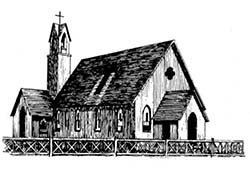According to an old newspaper article found among papers and historical documents at the Diocese of Newark's Cathedral House, Anglican worship began in the Pompton area in Northern New Jersey sometime in the 1750's when a Priest of the Church of England was summoned from Newark (about 30 miles distant) by the British Iron Company in order that the men in its employ "might receive the comfort and inspiration of the ancient liturgy of the church they loved." He arrived on horseback, set up his altar in one of the warehouses, "and the bell, which usually called the men together to collect their wages, was tolled to announce the opening of services. Thus was born the parish of Christ Church, Pompton."
The Parish of Christ Church, Pompton, was declared incorporated in 1798 by an act of the Legislature of the State of New Jersey. Descendants of the British Iron Company workers and newcomers to the area built the first church building, a small, wooden frame building on donated land near the Ramapo River sometime around 1864. It was in that first structure that the young Cecil B. De Mille listened to the Bible read by his father, Henry C. De Mille, a Warden and Lay Reader. Later the great director wrote, "I can remember going Sunday after Sunday to church with my father and listening to him preach. The 'King of Kings' had its genesis on those hard pews of the little Episcopal Church."
 In 1903, the Ramapo River experienced the "flood of the century", which demolished the church. In the same year, on high ground, closer to the developing center of Pompton, was built the present stone building of pink Pompton granite, with interior walls of grayish green stone with open timbered roof, finished in cathedral oak. The architect was Frederick E. Hill of New York City. Beginning in 1965, the original field glass was gradually replaced with stained glass windows based on an iconography which traces the faith from Creation to Pentecost. (A virtual tour of the windows can be seen at this location) A unique set of Stations of the Cross, carved by member-sculptor Michael DeNike, enhances the interior.
In 1903, the Ramapo River experienced the "flood of the century", which demolished the church. In the same year, on high ground, closer to the developing center of Pompton, was built the present stone building of pink Pompton granite, with interior walls of grayish green stone with open timbered roof, finished in cathedral oak. The architect was Frederick E. Hill of New York City. Beginning in 1965, the original field glass was gradually replaced with stained glass windows based on an iconography which traces the faith from Creation to Pentecost. (A virtual tour of the windows can be seen at this location) A unique set of Stations of the Cross, carved by member-sculptor Michael DeNike, enhances the interior.
After a fire in the adjoining Rectory in the year following its construction, the Rectory was replaced by a Parish Hall. In 1956 a larger Parish Hall, classrooms and offices were added. In 1995, another fire demolished the Parish Hall, which was rebuilt with an emphasis on present and future use.

